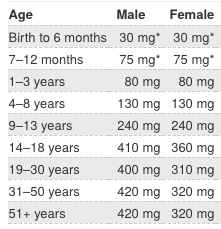Topical Magnesium Cream – new way to treat Hypertension?
In my never-ending search for yet one more possible natural solution for high blood pressure, I recently came across another option for consideration.
This one I like because it offers a treatment which may be applied externally to the body rather than needing to be taken orally. And for those of us who have trouble swallowing pills, this will come as a nice relief.
So today’s post is going to take a closer look at the use of MAGNESIUM CREAM as an effective treatment for people coping with high blood pressure.
Magnesium Deficiency – a chronic problem?
According to the National Institutes of Health, Magnesium is a very important mineral and is …
… needed for more than 300 biochemical reactions in the body. It helps maintain normal muscle and nerve function, keeps heart rhythm steady, supports a healthy immune system, and keeps bones strong. Magnesium also helps regulate blood sugar levels, promotes normal blood pressure, and is known to be involved in energy metabolism and protein synthesis. There is an increased interest in the role of magnesium in preventing and managing disorders such as hypertension, cardiovascular disease, and diabetes.”
Thus Magnesium deficiency can become a serious health risk, especially when a recent study* has shown that a whopping 68% of Americans do not consume the recommended daily dosage of Magnesium!! And even more disturbingly almost one fifth do not even get one half of the Recommended Daily Intake (RDI) of Magnesium!
(*King D, Mainous A 3rd, Geesey M, Woolson R. Dietary magnesium and C-reactive protein levels. J Am Coll Nutr. Jun 24(3))
Adding transdermal Magnesium Cream to the mix!!
There are a number of ways of addressing this Magnesium Deficiency
- Increasing Magnesium-rich foods in one’s diet
- Taking Magnesium supplements
- and, now the newcomer to the list…. Using Magnesium Cream transdermally.
==▶︎ CLICK HERE FOR MORE INFO ON ESSENTIAL MINERALS AND HYPERTENSION ◀︎==
Why bother with Cream?
Well, one real advantage about using a cream, rather than taking pills is simply that some of us have difficulty swallowing and ingesting pills. This provides an ideal alternative way to boost Magnesium levels in the body.
But is a topical application as effective as taking pills?
In short it can be, and in the case of some patients who have less than optimal absorption via the digestive tract, they may very well benefit more from using a cream as the delivery method to the body.
The Daily Mail recently reported on a new study – the first of its kind – which focussed on the use of Magnesium Transdermal Cream. The ultimate goal of the research was to see how well the Magnesium cream is absorbed into the body and subsequently whether it may be used as a viable alternative to prescribing tablets for treating Magnesium deficiency.
As study author Lindsay Kass says:
“Low magnesium intake has been shown to cause many health problems, including high blood pressure and cardiovascular issues, so these creams could potentially be a good way to contribute to the increase in magnesium levels and therefore help in reducing the associated health problems.”
The study was conducted over a 2 week period and involved the test subjects applying 10ml of Magnesium Cream to their skin twice a day. A placebo control group was also included in the study. After 14 days the urine levels of the test subjects were taken and found to contain a higher concentration of Magnesium than found in the placebo group.
This is encouraging news for sure!
The researchers are now advocating for more trials to be conducted using the Magnesium Cream at higher levels over a longer period of time!
Hang On – Can’t we just get the Magnesium from food sources?
Ideally, we would all benefit from increasing the Magnesium which is naturally available in the foods we eat. However, with today’s fast pace of life and hectic schedules and the convenience of processed and fast foods, we don’t always manage to get all the necessary nutrients, including magnesium, in the food we eat.
Still by educating ourselves about Magnesium-rich foods we definitely could then take better efforts to incorporate these foods into our daily diets.
Below is a table of the top 20 food sources of Magnesium: (click here for more info)
And the following are the recommended daily requirements of Magnesium (taken from the same source)

Daily Magnesium Recommended Quotas
Footnote – When Choosing Magnesium Supplements:
It’s important to be aware that Magnesium supplements can come in different forms, some of which are more efficiently absorbed by the body and thus are more bio-available!
The best forms of Magnesium for optimal absorption rates are:
- Magnesium Orotate – this is the best form with the highest absorption
- Magnesium Citrate – has a 90% bio-availability (but too much may cause diarrhea so should be taken with advisement!)
- Magnesium Aspartate or Arginate – these are chelated forms with lower levels of Magnesium but high bio-availability.
The Final Word
Without a doubt Magnesium is an important mineral which the body depends upon for many functions, including regulation of blood pressure.
The typical Western diet of processed foods, fast foods and an over-consumption of carbohydrates and sugars can easily lead to Magnesium deficiency, amongst other things, which in the long run can result in serious health issues.
So, if you are finding that your BP readings are not where you would like them, it may be worth your while to have your Doctor check your Magnesium levels through a simple blood test.
And if they are low, then you have options for how to deal with this deficiency naturally which may very well help your blood pressure management, too!
And using a good quality Magnesium Cream may very well be just what the Doctor ordered. It would certainly be worth a try!!
